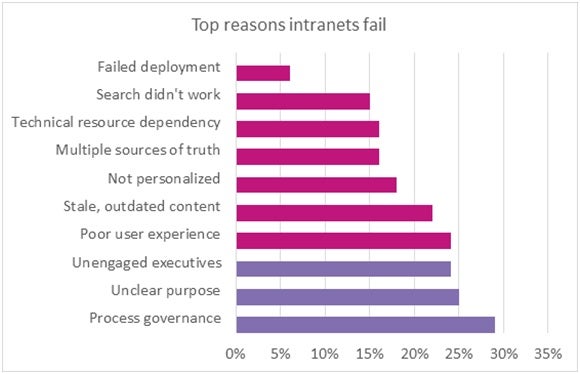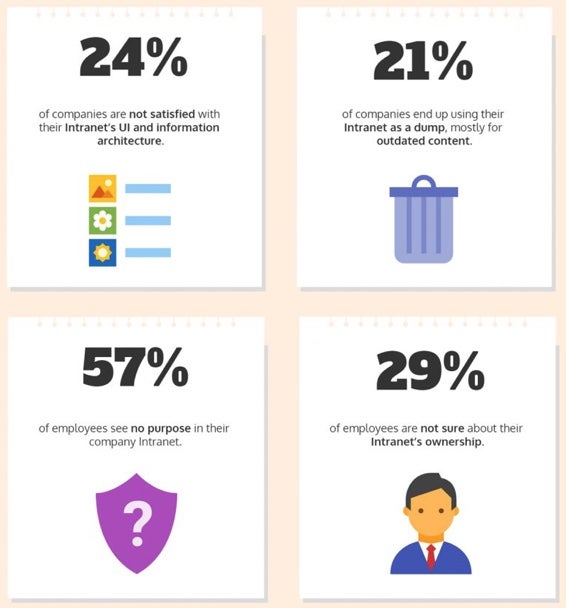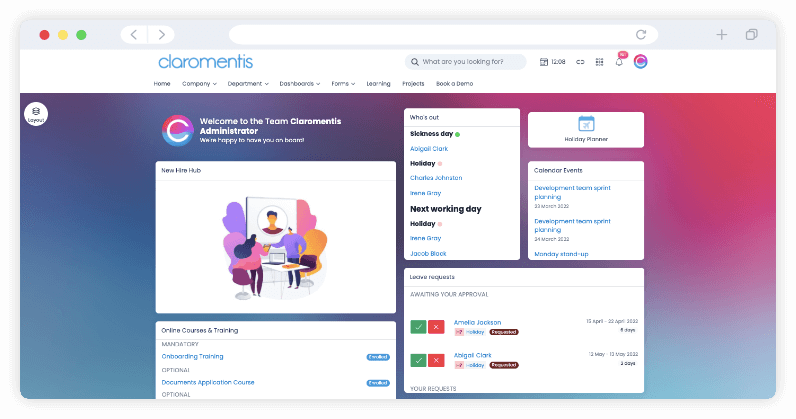When selecting an intranet solution, one of the most critical steps is creating a requirements document.
This document outlines your intranet business case and helps you choose the right intranet software for your unique business needs.
This step is crucial. There are many different intranet products and platforms available – so it’s critical the right solution is chosen. The proper way to do this is to gather specific requirements from the people who will be using the intranet every single day – employees, managers, and all other stakeholders.
The truth is that business software is often purchased based on a list of features. While this kind of loose, check-box process can sometimes result in suitable solution, it’s an approach that relies more on luck than judgement. A platform is selected because it has most of the features deemed important – but soon after implementation it becomes apparent that they are clunky and difficult to use and don’t improve workflows. As a result, employees don’t use the intranet, and so it becomes a money pit – a wasted resource.
The way to avoid this trap is to conduct a thorough needs analysis process through gathering and documenting intranet requirements from the people who will be using it – be they HR managers and staff, IT managers and staff, sales, marketing, and customer relationship managers and staff, field workers, executives, board members, or all of the above.
For each potential requirement, you need to identify who the user is, what they want, and why they want it, and then document the findings.
Taking this approach will avoid selecting an intranet solution based merely on a long list of features and prevent the project from being consigned to the graveyard of intranet failures due to poor user experiences, unengaged users, and an unclear purpose.

(Image source: IndustryAnalysts.com)
By establishing not just a wish list of features, but the reasons as to why these features are important, how they will be used, and who will use them, you will be in much better placed when it comes to vetting solutions and discussing your needs with solution providers.
In essence, an intranet requirements document establishes context – and context removes assumptions and guesswork, which are so often the root cause of intranet failure for organisations.

(Image source: typewriter.media)
By establishing context for each required use case in a thoughtfully created intranet requirements document, a good intranet vendor will help you determine precisely how to build and align a solution to your users’ actual, rather than assumed needs and your overall business strategy. The vendor can then advise you not only on features and functionality, but on customisations and integrations that will enable you to achieve all your intranet goals, support useability, and give your intranet project the best chance of success.
Let’s now dive a little deeper into what you need to establish in an effective intranet requirements document that clarifies your purposes and supports your intranet business case.
Conduct employee interviews and surveys – who are your intranet users and what do they want?
Firstly, you need to survey or interview your employees – both end users and managers – to establish what they need from an intranet solution to boost productivity and streamline processes, collaboration efforts, and communications.
Employee surveys are one of the most underrated tools, yet one of the quickest ways to get feedback from a broad cross-section of your workforce.
The goal of these surveys is to solidify the ultimate purpose of the solution, and how the intranet will achieve it.
Importantly, survey questions should be designed to elicit precise business objectives, rather than a list of features. What you’re trying to uncover at this stage is underlying business pain points that you need a company intranet to solve.
Your questions should also seek to establish what communication pathways currently look like throughout the organisation so you can obtain a clear overview of how information flows between departments – and if there are any bottlenecks or dead ends that need to be addressed.
Sample survey questions include:
- What is the function of your team or department?
- Can you describe your role?
- Do you work from home, in the field, at the office, or in combination of the above?
- What is the most time-consuming part of your daily routine?
- Where do you go or who do you ask to find information and documents to complete daily tasks?
- Who do you work with closely on a daily/weekly basis, and what do you work on?
- Who do you communicate with regularly, and how is that communication currently facilitated?
- What communication and collaboration barriers do you currently encounter in the workplace?
- What software and applications does your team currently use to get work done?
- What is your team’s most important goals and priorities?
- How do you think a company intranet could help achieve these goals and overcome any barriers you or your team currently face?
Use answers to document business objectives
The answers you receive from your employee interviews should uncover some strong business objectives for your company intranet.
It is likely that they will centre around improving knowledge management, communication, collaboration, employee engagement, workplace culture, and business efficiency – as these are the primary reasons why organisations invest in intranet software solutions.
However, using the information gained from your survey, together with any additional observations you and other board members have made, you should now be able to create a short list of specific business objectives you need your intranet to achieve.
For example, a list of business objectives may contain the following:
- Improve the findability of documents and information needed to complete daily tasks – including from home and on mobile
- Provide easier ways for separate teams/departments to collaborate on projects and documents
- Improve remote workers’ access to important company alerts and information
- Reduce time spent reading and responding to emails across the organisation
- Ensure all employees receive company communications in a timely fashion
Refine objectives into specific intranet requirements for specific users
At this point you will have a clear view of the overarching goals of your intranet project.
The next stage is to refine this information into specific use cases for specific users. These use cases will be the basis for creating an intranet requirements document you can present to vendors as you evaluate different platforms and take a look at free trials and demos.
Your list of requirements should take a “who, what, why” format.
Let’s take a look at some examples.
HR Manager example
Requirement 1
- Who? – HR Manager
- What? – Tool for creating appraisal e-forms and workflows
- Why? – HR can easily evaluate employee performance, process appraisals through a predefined workflow, and automatically assign to relevant team members for review
Requirement 2
- Who? – HR Manager
- What? – Leave management tool
- Why? – Department can save time processing holiday leave requests and approvals
The key advantage of detailing your specific intranet requirements in this fashion is that you can easily evaluate whether an intranet solution can fulfil specific business goals. It also helps potential vendors determine how best your requirements can be realised.
For example, when clients come to Claromentis with a requirement for a leave management tool, we show them our Holiday Planner, which allows employees to ping holiday requests straight to their line managers for approval. The tool not only eliminates the need for HR to manually process holiday leave requests, it also sets holiday quotas for every employee, and provides at-a-glance information about who’s in and out of the office every single day.

Claromentis’ Holiday Planner includes homepage dashboards that make it easy to process leave requests. (Image source: claromentis.com)
End user example
Requirement
- Who? – End User
- What? – Find documents, information, and people quickly and easily
- Why? – To stop wasting time finding the resources I need
Employees often waste many hours each week simply trying to hunt down information, documents, and expertise. This hinders productivity and drains morale.
With this requirement identified, you can look for a solution that offers robust document management with a powerful search function, as well as an internal communications tool and people finder.
Communications Manager example
Requirement
- Who? – Communications Manager
- What? – Tool for disseminating both company-wide and department-specific news, information, and alerts
- Why? – Employees receive relevant and timely communications that are tailored to their respective roles
If your communications manager highlights a need for a platform to distribute important news and information to employees and employee segments, you know you need an intranet solution that provides the ability to create newsfeeds, enables corporate social networking, and generates notifications to alert employees to information updates.
Final thoughts on intranet requirements documents
Compiling a thorough intranet requirements document that details the who, what, and why of specific use cases gives you a crystal-clear picture of what you need your intranet to achieve for all members of your organisation.
Rather than relying on a cobbled together list of nice-to-have features, take the time to conduct interviews and surveys, distil the answers into business objectives, and then refine these objectives into a detailed list of specific requirements. This will give you a comprehensive document you can take to vendors as you evaluate their solutions, ensuring you have the precise information you need to select the right one.

![[FREE DOWNLOAD] Business Requirements Gathering Template](https://no-cache.hubspot.com/cta/default/5025095/46c08df3-3774-48e4-9bde-b5f02208ccd7.png)




